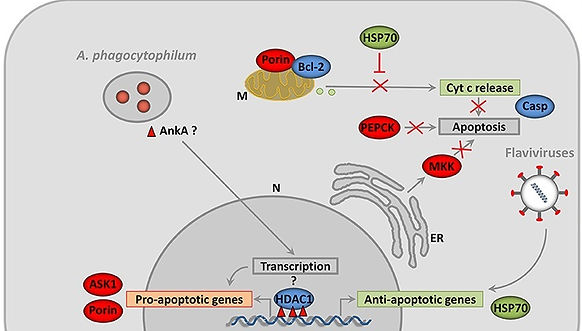top of page

Tick-pathogen interactions

Figure from (Front Cell Infect Microbiol. 2017; 7:114)
Key Information: Anaplasma phagocytophilum is the most widespread tick-borne pathogen affecting animals in Europe and poses significant health risks to humans. Research has established that A. phagocytophilum targets granulocytes in vertebrates, while in ticks, it primarily infects the midgut, hemocytes, and salivary glands. Although the infection does not seem to harm the tick, it triggers significant transcriptional reprogramming and proteome changes in tick cells. These modifications likely play a crucial role in the pathogen's evolutionary adaptation to its multi-host lifestyle. Our previous work identified several cellular components and processes impacted by A. phagocytophilum, including the cytoskeleton, apoptosis, metabolism, cell immunity, and epigenetics.
Similarly, Borrelia, the causative agent of Lyme disease, is a major tick-borne pathogen that affects both humans and animals across Europe and North America. Borrelia burgdorferi infects multiple host tissues and is known for its ability to evade the immune system by varying its surface proteins. This adaptation facilitates chronic infection, complicating treatment and diagnosis. In ticks, Borrelia primarily colonizes the midgut before migrating to the salivary glands, which facilitates transmission to new hosts during feeding. Understanding the complex interactions between Borrelia and its hosts at the molecular level remains a critical focus of current research.
Current Focus: This project is currently dedicated to exploring and delineating the molecular mechanisms that drive the transcriptional reprogramming in ticks and tick cells caused by A. phagocytophilum and Borrelia infections. We are employing functional experiments, in silico analyses, and network analysis as tools to synthesize omics data, aiming to provide a comprehensive understanding of the pathogen-induced changes for both pathogens. This holistic approach is essential for developing targeted interventions that can effectively manage and potentially eradicate these complex infections.
bottom of page
